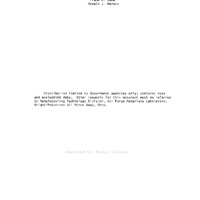-
Title
-
Comparison of Major Forging Systems
-
Date
-
1971
-
Index Abstract
-
Not Available
-
Photo Quality
-
Complete
-
Report Number
-
AFML TR 71-112
-
Creator
-
Lake, Frank N.
-
Moracz, Donald J.
-
Corporate Author
-
TRW Inc.
-
Laboratory
-
Air Force Materials Laboratory
-
Extent
-
315
-
Identifier
-
AD0887384
-
Access Rights
-
Distribution limited to Government agencies only; contains test and evaluation data.
-
Distribution Classification
-
1
-
Contract
-
F33615-67-C-1109
-
DoD Project
-
9120
-
DoD Task
-
None Given
-
DTIC Record Exists
-
No
-
Distribution Change Authority Correspondence
-
AFML LTR
-
Distribution Conflict
-
No
-
Abstract
-
A program to compare forging equipment effectiveness in providing superior structural forgings of advanced aerospace materials has been successfully completed. Comparisons of precision, quality, properties, and costs have been made after evaluation of representative, rectangular, rib and web structural forgings produced essentially common shapes with different forging equipment. The program was divided by equipment size into separate efforts involving intermediate size and large forgings. An "H" section, leading edge fin rib was employed as a target component enveloped by intermediate size forgings produced of a high strength steel (D6ac), a titanium alloy (Ti 6Al-4V), and a nickel-based alloy (Inconel 718). Subcontractors and equipment items employed were: Ladish Company, hammer and mechanical press; Cameron Iron Works, hydraulic press; and Precision Metal Products, CEFF-type HERF machine. Results of TRW dimensional evaluation revealed little difference in overall tolerance levels maintained during production of the forgings. Section thinness characteristics were, however, considerably different. The CEFF machine forgings were thinnest by design, and the hydraulic press forgings were thickest because the die closure rate was too slow to prevent excessive chilling of the forgings. Forging quality features relative to defects and uniformity of macro- and microstructural characteristics were also considerably different. Program results in this regard have conclusively demonstrated the importance of equipment closure mode and rate in maintaining a uniform, metallurgically correct workpiece temperature profile during deformation. Mechanical property levels of the thee materials were not significantly different as a function of the equipment which produced the forgings.An "H" section fuselage bulkhead with cross ribs was the target shape which was enveloped by large forgings of the D6ac and the Ti 6Al-4V materials. The Ladish Company (125,000 MKG counterblow hammer) and Alcoa (50,000 ton hydraulic press) designed and successfully produced the bulkhead forgings. Results of TRW evaluation indicated that overall control of dimensional tolerances was similar in both instances, but that the hammer forgings were considerably lighter in weight and thinner in section. Relative to quality, the macro- and microstructural features of the hammer forgings were more uniform, but the degree of thinness and detail achieved by the hammer also resulted in the onset of a "lapping" tendency in the titanium alloy forgings at rib-web fillet radii formed by the upper die. As with smaller forgings, mechanical testing did not reveal significant differences in property levels between the bulkhead forgings produced by the different machinesIn general, hammers and hydraulic presses are both cost effective in forging oversize structurals to the variety of shapes, sizes, and materials in the low to medium quantity requirements typical of aerospace applications. However, due to chilling by the dies, higher temperature die systems must be used with typical hydraulic presses to achieve the same degree of detail and quality which can be obtained using conventional, economical dies in a hammer. Mechanical presses and HERF machines are limited in application to structurals because of more limited control in die closure characteristics.
-
Report Availability
-
Full text available
-
Date Issued
-
1971-05
-
Provenance
-
Lockheed Martin Missiles & Fire Control
-
Type
-
report
-
Format
-
1 online resource
 AFMLTR71-112.pdf
AFMLTR71-112.pdf